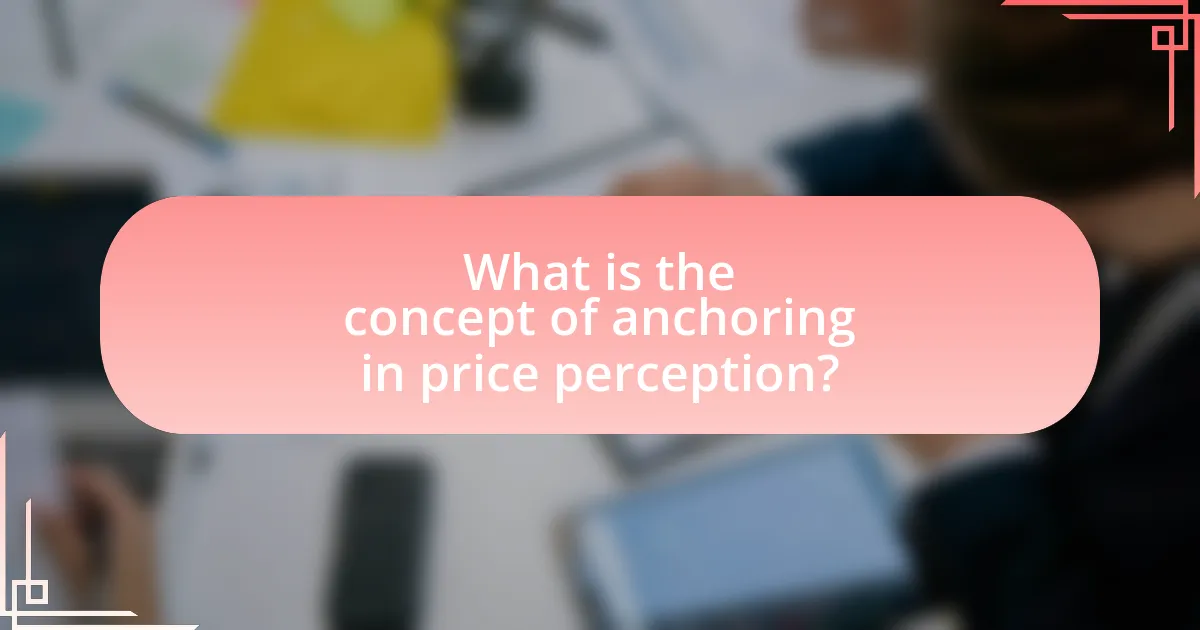The article examines the concept of anchoring in price perception, a cognitive bias where individuals rely on the first piece of information encountered when evaluating prices. It explores how anchoring influences consumer behavior, the psychological mechanisms behind it, and its significance in pricing strategies. The article also discusses different types of anchoring effects, techniques for leveraging anchoring in marketing, and practical strategies consumers can use to counteract its influence. Additionally, it highlights the importance of awareness in mitigating anchoring effects and provides tips for effective price research.

What is the concept of anchoring in price perception?
The concept of anchoring in price perception refers to the cognitive bias where individuals rely heavily on the first piece of information encountered (the “anchor”) when making decisions about price. This bias affects how consumers evaluate the value of products or services, often leading them to perceive prices in relation to the anchor rather than their intrinsic value. For example, if a consumer sees a jacket priced at $200 and then finds a similar jacket marked down to $100, the $200 price serves as an anchor, making the $100 price seem like a great deal, even if the actual value of the jacket is lower. Research by Tversky and Kahneman in 1974 established that anchors significantly influence decision-making processes, demonstrating that initial price points can skew perceptions of value and affect purchasing behavior.
How does anchoring influence consumer behavior?
Anchoring significantly influences consumer behavior by establishing a reference point that affects subsequent judgments and decisions regarding prices. When consumers are exposed to an initial price, this anchor shapes their perception of value, leading them to evaluate subsequent prices in relation to that anchor. For example, a study by Tversky and Kahneman demonstrated that individuals who were first shown a high anchor price were likely to perceive lower prices as more attractive, thus increasing the likelihood of purchase. This cognitive bias illustrates how anchoring can manipulate consumer perceptions and ultimately drive purchasing decisions.
What psychological mechanisms underlie anchoring effects?
Anchoring effects are primarily underpinned by cognitive biases, particularly the anchoring and adjustment heuristic. This mechanism occurs when individuals rely heavily on the first piece of information encountered (the anchor) when making decisions, leading to skewed judgments. Research by Tversky and Kahneman (1974) demonstrated that participants’ numerical estimates were significantly influenced by arbitrary anchors, illustrating how initial exposure shapes subsequent evaluations. This cognitive reliance on anchors can distort perceptions of value, particularly in pricing contexts, where initial price points can disproportionately affect consumer willingness to pay.
How does initial price information serve as an anchor?
Initial price information serves as an anchor by establishing a reference point that influences consumers’ perceptions of subsequent prices. This anchoring effect occurs because individuals rely heavily on the first piece of information they encounter when making decisions, which can skew their judgment regarding value. Research by Tversky and Kahneman (1974) demonstrates that when consumers are presented with an initial price, they tend to adjust their evaluations of other prices based on that anchor, often leading to biased assessments. For example, if a product is initially priced at $100, subsequent prices, even if lower, may still be perceived as expensive due to the initial anchor. This phenomenon illustrates how initial price information can significantly shape consumer behavior and decision-making in the marketplace.
Why is anchoring important in pricing strategies?
Anchoring is important in pricing strategies because it influences consumer perception of value and price fairness. When consumers are presented with an initial price point, known as the anchor, it serves as a reference for evaluating subsequent prices. Research by Tversky and Kahneman demonstrates that individuals rely heavily on the first piece of information encountered, which can skew their judgment and decision-making. For example, if a product is initially priced at $100 and then discounted to $70, the $100 serves as an anchor, making the $70 price appear more attractive and reasonable. This psychological effect can significantly enhance sales and profitability by shaping consumer expectations and perceptions of value.
What role does anchoring play in perceived value?
Anchoring significantly influences perceived value by establishing a reference point that shapes consumer judgments. When individuals encounter an initial price or value, this anchor affects their subsequent evaluations, often leading them to perceive related prices as more or less favorable based on that initial reference. Research by Tversky and Kahneman (1974) demonstrated that individuals’ estimates of numerical values are heavily influenced by the first number they see, illustrating how anchors can skew perceptions of value. This cognitive bias can lead consumers to perceive a product as more valuable if its price is presented alongside a higher anchor, thereby enhancing its attractiveness and perceived worth.
How can businesses leverage anchoring to enhance sales?
Businesses can leverage anchoring to enhance sales by strategically setting initial price points that influence customer perceptions of value. For example, when a business introduces a high-priced item alongside a lower-priced alternative, the higher price serves as an anchor, making the lower price appear more attractive. Research by Tversky and Kahneman (1974) demonstrates that individuals rely heavily on the first piece of information they encounter when making decisions, which in this case is the initial price. By utilizing this psychological principle, businesses can effectively guide consumer choices and increase the likelihood of purchase.

What are the different types of anchoring effects?
The different types of anchoring effects include numerical anchoring, categorical anchoring, and contextual anchoring. Numerical anchoring occurs when individuals rely on a specific number as a reference point for making decisions, such as pricing. Categorical anchoring involves the influence of categories or labels on perceptions, affecting how options are evaluated within those categories. Contextual anchoring refers to the impact of surrounding information or environment on decision-making, where the context shapes the perceived value of an option. Research by Tversky and Kahneman in 1974 established the foundational understanding of anchoring effects, demonstrating how initial exposure to a number can significantly influence subsequent judgments and decisions.
How do different anchoring techniques vary in effectiveness?
Different anchoring techniques vary in effectiveness based on their context and application. For instance, numerical anchors, such as presenting a high initial price before a discount, significantly influence consumer perception of value, as demonstrated in studies where participants exposed to higher initial prices perceived subsequent prices as more favorable. Research by Tversky and Kahneman (1974) highlights that the effectiveness of anchoring is contingent upon the relevance and specificity of the anchor to the decision at hand. Additionally, contextual factors, such as the consumer’s prior knowledge and the framing of the anchor, can further modulate the impact of anchoring techniques on price perception.
What is the difference between external and internal anchors?
External anchors are reference points that originate from outside an individual, such as market prices or competitor pricing, while internal anchors are reference points that come from within an individual, such as personal expectations or past experiences. Research indicates that external anchors can significantly influence consumer behavior by providing a context for evaluating prices, whereas internal anchors shape perceptions based on individual biases and prior knowledge. For example, a study published in the Journal of Consumer Research by Tversky and Kahneman demonstrates how external anchors can skew price perception, leading consumers to perceive a product as more or less valuable based on the presented external information.
How does the context of an anchor affect its impact?
The context of an anchor significantly influences its impact on price perception by shaping how consumers evaluate subsequent prices. Anchors, such as initial price points or reference prices, create a mental benchmark that affects decision-making. For instance, a study by Tversky and Kahneman (1974) demonstrated that when participants were exposed to a high initial price, they perceived subsequent prices as more favorable, even if those prices were still high. This illustrates that the context in which an anchor is presented can skew consumer judgment, leading to altered perceptions of value and willingness to pay.
What are common examples of anchoring in marketing?
Common examples of anchoring in marketing include the use of reference prices, promotional pricing strategies, and tiered pricing structures. Reference prices, such as displaying a higher original price next to a discounted price, create a perception of value by anchoring consumers’ expectations. Promotional pricing strategies, like “buy one, get one free,” anchor the perceived value of the product by comparing it to a higher price point. Tiered pricing structures, where products are offered at different price levels, anchor consumer choices by establishing a baseline for what is considered a reasonable price for a given quality or feature set. These strategies effectively influence consumer behavior by shaping their price perceptions and decision-making processes.
How do retailers use anchoring in pricing promotions?
Retailers use anchoring in pricing promotions by presenting a higher original price alongside a discounted price to create a perception of value. This strategy leverages the cognitive bias where consumers rely heavily on the initial price as a reference point, making the discounted price appear more attractive. For example, if a product is marked down from $100 to $70, the original price serves as an anchor, leading consumers to perceive the $70 price as a significant savings. Research indicates that consumers are more likely to purchase items when they perceive they are getting a deal based on the anchored price, thus enhancing the effectiveness of promotional strategies.
What are some case studies demonstrating anchoring effects?
Case studies demonstrating anchoring effects include the research conducted by Tversky and Kahneman in 1974, which illustrated how initial numerical information can influence subsequent judgments. In their study, participants were asked to estimate the percentage of African nations in the United Nations after being exposed to a random number generated by a spinning wheel. The estimates were significantly influenced by the initial anchor, showcasing how arbitrary numbers can skew perceptions.
Another notable case study is the experiment by Ariely, Loewenstein, and Prelec in 2003, where participants were asked to bid on items after being exposed to irrelevant anchors, such as the last two digits of their Social Security numbers. The results indicated that those exposed to higher anchors placed higher bids, demonstrating the powerful impact of anchoring on financial decision-making.
Additionally, a study by Thomas and Morwitz in 2005 examined how anchors affect consumer price perceptions. Participants were shown a product with a high initial price and then a discounted price. The study found that the initial high price served as an anchor, leading consumers to perceive the discounted price as a better deal, thus influencing their purchasing decisions.

How can consumers be aware of anchoring effects?
Consumers can be aware of anchoring effects by actively questioning initial price information presented to them. Research indicates that when consumers recognize the influence of an initial price point on their perception of value, they can make more informed purchasing decisions. For instance, studies show that consumers who are educated about anchoring are less likely to be swayed by misleading price comparisons, allowing them to evaluate products based on their true worth rather than arbitrary reference points.
What strategies can consumers use to counteract anchoring?
Consumers can counteract anchoring by actively seeking additional information and comparing prices across different sources. By researching alternative products and their prices, consumers can reduce the influence of an initial price point that may skew their perception. Studies show that when consumers are exposed to a range of prices, they are less likely to be swayed by a single anchor, leading to more informed purchasing decisions. For instance, a study published in the Journal of Consumer Research found that consumers who were presented with multiple price options made more rational choices compared to those who only saw a single price.
How can consumers evaluate prices independently of anchors?
Consumers can evaluate prices independently of anchors by utilizing comparative analysis and personal value assessment. By comparing prices across different retailers or similar products, consumers can form a more objective understanding of value rather than relying on initial price points. Research indicates that when consumers focus on their own needs and preferences, they are less influenced by initial price cues. For instance, a study published in the Journal of Consumer Research found that consumers who were prompted to consider their budget and specific product benefits made more informed purchasing decisions, demonstrating that personal context can mitigate the effects of anchoring.
What role does awareness play in mitigating anchoring effects?
Awareness plays a crucial role in mitigating anchoring effects by enabling individuals to recognize and adjust for the influence of initial information on their judgments. When individuals are aware of the anchoring bias, they are more likely to critically evaluate the relevance of the anchor and make more informed decisions. Research by Tversky and Kahneman demonstrates that when participants are informed about the potential for anchoring, they adjust their estimates more appropriately, reducing the bias’s impact on their final judgments. This awareness allows for cognitive strategies that counteract the automatic reliance on anchors, leading to more accurate price perceptions.
What practical tips can consumers apply to avoid being influenced by anchoring?
Consumers can avoid being influenced by anchoring by actively seeking out independent price information before making a purchase. This practice helps to counteract the initial price presented, which often serves as an anchor. Research indicates that when consumers compare prices from multiple sources, they are less likely to be swayed by the first price they encounter, thereby reducing the anchoring effect. For example, a study published in the Journal of Consumer Research found that consumers who were exposed to a range of prices for a product made more informed decisions and were less affected by the initial price they saw.
How can consumers research prices effectively before making a purchase?
Consumers can research prices effectively before making a purchase by utilizing online comparison tools and price tracking websites. These platforms aggregate prices from various retailers, allowing consumers to see the price range for a specific product, which helps in identifying the best deal. For instance, websites like PriceGrabber and CamelCamelCamel provide historical price data and alerts for price drops, enabling informed purchasing decisions. Research indicates that consumers who compare prices can save an average of 20% on their purchases, demonstrating the effectiveness of thorough price research.
What mindset shifts can help consumers resist anchoring?
To resist anchoring, consumers can adopt a mindset shift that emphasizes critical thinking and awareness of cognitive biases. By actively questioning initial price points and considering alternative options, consumers can mitigate the influence of anchors. Research indicates that when individuals are prompted to think about their own preferences and needs rather than relying solely on presented information, they are less likely to be swayed by anchors. For instance, a study published in the Journal of Consumer Research by Tversky and Kahneman demonstrates that awareness of anchoring effects can lead to more informed decision-making.


